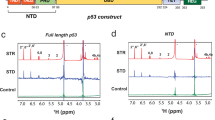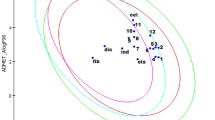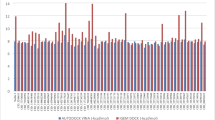Abstract
The MDM2–p53 protein–protein interaction is a promising model for researchers to design, study, and discover new anticancer drugs. The design of therapeutically active compounds that can maintain or restore the binding of MDM2 to p53 has been found to limit the oncogenic activities of both. This led to the current development of a group of xanthone-core and cis-imidazoline analogs compounds, among which γ-Mangostin (GM), α-Mangostin (AM), and Nutlin exhibited their MDM2–p53 interaction inhibitory effects. Therefore, in this study, we seek to determine the mechanisms by which these compounds elicit MDM2–p53 interaction targeting. Unique to the binding of GM, AM, and Nutlin, from our findings, they share the same three active site residues Val76, Tyr50, and Gly41, which represent the top active side residues that contribute to high electrostatic energy. Consequently, the free binding energy contributed enormously to the binding of these compounds, which culminated in the high binding affinities of GM, AM, and Nutlin with high values. Furthermore, GM, AM, and Nutlin commonly interrupted the stable and compact conformation of MDM2 coupled with its active site, where Cα deviations were relatively high. We believe that our findings would assist in the design of more potent active anticancer drugs.








Similar content being viewed by others
References
Teodoro, J. G., Evans, S. K., & Green, M. R. (2007). Inhibition of tumor angiogenesis by p53: a new role for the guardian of the genome. Journal of Molecular Medicine, 85(11), 1175–1186. https://doi.org/10.1007/s00109-007-0221-2.
Fridman, J. S., & Lowe, S. W. (2003). Control of apoptosis by p53. Oncogene, 22(56), 9030–9040. http://www.nature.com/articles/1207116.
Vousden, K. H., & Lu, X. (2002). Live or let die: the cell’s response to p53. Nature Reviews Cancer, 2(8), 594–604. http://www.nature.com/articles/nrc864.
Feki, A., & Irminger-Finger, I. (2004). Mutational spectrum of p53 mutations in primary breast and ovarian tumors. Critical Reviews in Oncology/Hematology, 52(2), 103–116. https://linkinghub.elsevier.com/retrieve/pii/S1040842804001222.
Fakharzadeh, S. S., Trusko, S. P., & George, D. L. (1991). Tumorigenic potential associated with enhanced expression of a gene that is amplified in a mouse tumor cell line. The EMBO Journal, 10(6), 1565–9. http://www.ncbi.nlm.nih.gov/pubmed/2026149.
Oliner, J. D., Kinzler, K. W., Meltzer, P. S., George, D. L., & Vogelstein, B. (1992). Amplification of a gene encoding a p53-associated protein in human sarcomas. Nature, 358(6381), 80–83. http://www.nature.com/articles/358080a0.
Momand, J. (1998). The MDM2 gene amplification database. Nucleic Acids Research, 26(15), 3453–3459. https://academic.oup.com/nar/article-lookup/doi/10.1093/nar/26.15.3453.
Momand, J., Zambetti, G. P., Olson, D. C., George, D., & Levine, A. J. (1992). The mdm-2 oncogene product forms a complex with the p53 protein and inhibits p53-mediated transactivation. Cell, 69(7), 1237–1245. https://linkinghub.elsevier.com/retrieve/pii/009286749290644R.
Wu, X., Bayle, J. H., Olson, D., & Levine, A. J. (1993). The p53-mdm-2 autoregulatory feedback loop. Genes & Development, 7(7a), 1126–1132. http://www.genesdev.org/cgi/doi/10.1101/gad.7.7a.1126.
Bai, L., & Wang, S. (2014). Targeting apoptosis pathways for new cancer therapeutics. Annual Review of Medicine., 65(1), 139–155. http://www.annualreviews.org/doi/10.1146/annurev-med-010713-141310.
Momand, J., Wu, H. H., & Dasgupta, G. (2000). MDM2 - Master regulator of the p53 tumor suppressor protein. Gene, 242(1–2), 15–29.
Moll, U. M., & Petrenko, O. (2003). The MDM2p53 interaction, 1, 1001–1008.
Klein, C., & Vassilev, L. T. (2004). Targeting the p53–MDM2 interaction to treat cancer. British Journal of Cancer, 91(8), 1415–1419. http://www.nature.com/articles/6602164.
Shangary, S., & Wang, S. (2009). Small-molecule inhibitors of the MDM2-p53 protein-protein interaction to reactivate p53 function: a novel approach for cancer therapy. Annual Review of Pharmacology and Toxicology, 49(1), 223–241. http://www.annualreviews.org/doi/10.1146/annurev.pharmtox.48.113006.094723.
Selivanova, G. (2010). Therapeutic targeting of p53 by small molecules. Seminars in Cancer Biology, 20(1), 46–56. https://linkinghub.elsevier.com/retrieve/pii/S1044579X10000076.
Stegh, A. H. (2012). Targeting the p53 signaling pathway in cancer therapy – the promises, challenges and perils. Expert Opinion on Therapeutic Targets, 16(1), 67–83. http://www.tandfonline.com/doi/full/10.1517/14728222.2011.643299.
Essmann, F., & Schulze-Osthoff, K. (2012). Translational approaches targeting the p53 pathway for anticancer therapy. British Journal of Pharmacology, 165(2), 328–344. https://doi.org/10.1111/j.1476-5381.2011.01570.x.
Ray-Coquard, I., Blay, J. Y., & Italiano, A., et al. (2012). Effect of the MDM2 antagonist RG7112 on the P53 pathway in patients with MDM2-amplified, well-differentiated or dedifferentiated liposarcoma: An exploratory proof-of-mechanism study. Lancet Oncology, 13(11), 1133–1140.
Lyubomir, T. V., Binh, T. V., Bradford, G., Daisy, C., Frank, P., Zoran, F., & Norman, K. U. (2004). In vivo activation of the p53 Pathway by Small-Molecule Antagonists of MDM2. Science, 303(3), 73–74.
Weber, L. (2010). Patented inhibitors of p53–Mdm2 interaction (2006–2008). 20, 179–191.
Zak, K., Pecak, A., & Rys, B., et al. (2013). Mdm2 and MdmX inhibitors for the treatment of cancer: a patent review (2011-present). Expert Opinion on Therapeutic Patents, 23(4), 425–448.
Darmawan, D. (2019). Inhibition of p53 inhibitors: progress, challenges and perspectives. Journal of Chemical Information and Modeling, 53(9), 1689–1699.
Cui, J., Hu, W., & Cai, Z., et al. (2010). New medicinal properties of mangostins: Analgesic activity and pharmacological characterization of active ingredients from the fruit hull of Garcinia mangostana L. Pharmacology Biochemistry and Behavior, 95(2), 166–172.
Sukma, M., Tohda, M., Suksamran, S., & Tantisira, B. (2011). γ-Mangostin increases serotonin 2A/2C, muscarinic, histamine and bradykinin receptor mRNA expression. Journal of Ethnopharmacology, 135(2), 450–454.
Buelna-Chontal, M., Correa, F., Hernández-Reséndiz, S., Zazueta, C., & Pedraza-Chaverri, J. (2011). Protective effect of α-mangostin on cardiac reperfusion damage by attenuation of oxidative stress. Journal of Medicinal Food, 14(11), 1370–1374.
Seesom, W., Jaratrungtawee, A., Suksamrarn, S., Mekseepralard, C., Ratananukul, P., & Sukhumsirichart, W. (2013). Antileptospiral activity of xanthones from Garcinia mangostana and synergy of gamma-mangostin with penicillin G. BMC Complementary and Alternative Medicine, 13, 2–7.
Ibrahim, M. Y., Hashim, N. M., & Mariod, A. A., et al. (2016). α-Mangostin from Garcinia mangostana Linn: An updated review of its pharmacological properties. Arabian Journal of Chemistry, 9(3), 317–329.
Chen, G., Li, Y., Wang, W., & Deng, L. (2018). Bioactivity and pharmacological properties of α-mangostin from the mangosteen fruit: a review. Expert Opinion on Therapeutic Patents, 28(5), 415–427.
El Habbash, A. I., Hashim, N. M., & Ibrahim, M. Y. et al.(2007). In vitro assessment of anti-proliferative effect induced by α-mangostin from Cratoxylum arborescens on HeLa cells. PeerJ, 5, e3460. https://doi.org/10.7717/peerj.3460.
Lee, C. H., Ying, T. H., & Chiou, H. L., et al. (2017). Alpha-mangostin induces apoptosis through activation of reactive oxygen species and ASK1/p38 signaling pathway in cervical cancer cells. Oncotarget, 8(29), 47425–47439.
Balunas, M. J., Su, B., Brueggemeier, R. W., & Kinghorn, A. D. (2008). Xanthones from the botanical dietary supplement mangosteen (Garcinia mangostana) with aromatase inhibitory activity. Journal of Natural Products, 71, 1161–1166.
Chang, H. F., & Yang, L. L. (2012). Gamma-mangostin, a micronutrient of mangosteen fruit, induces apoptosis in human colon cancer cells. Molecules, 17(7), 8010–8021.
Shibata, M. A., Iinuma, M., & Morimoto, J., et al. (2011). α-Mangostin extracted from the pericarp of the mangosteen (Garcinia mangostana Linn) reduces tumor growth and lymph node metastasis in an immunocompetent xenograft model of metastatic mammary cancer carrying a p53 mutation. BMC Medicine, 9, 1–18.
Watanapokasin, R., Jarinthanan, F., & Jerusalmi, A., et al. (2010). Potential of xanthones from tropical fruit mangosteen as anticancer agents: Caspase-dependent apoptosis induction in vitro and in mice. Applied Biochemistry and Biotechnology, 162(4), 1080–1094.
Leão, M., Gomes, S., & Pedraza-Chaverri, J., et al. (2013). α-mangostin and gambogic acid as potential inhibitors of the p53-MDM2 interaction revealed by a yeast approach. Journal of Natural Products, 76(4), 774–778.
Berman, H. M., Battistuz, T., & Bhat, T. N., et al. (2002). The protein data bank. Acta Crystallogr. D. Biol. Crystallogr. [Internet], 58(Pt 6 No 1), 899–907. http://www.ncbi.nlm.nih.gov/pubmed/12037327.
Vaupel, A., Holzer, P., & Ferretti, S., et al. (2018). In vitro and in vivo characterization of a novel, highly potent p53-MDM2 inhibitor. Bioorganic & Medicinal Chemistry Letters, 28(20), 3404–3408. https://linkinghub.elsevier.com/retrieve/pii/S0960894X18307030.
Pettersen, E. F., Goddard, T. D., & Huang, C. C., et al. (2004). UCSF Chimera - a visualization system for exploratory research and analysis. Journal of Computational Chemistry, 25(13), 1605–1612.
Susi, K., Emil, B., Soleh, K., & Wahono, S. F. J. (2014). The molecular docking of 1,4-naphthoquinone derivatives as inhibitors of Polo-like kinase 1 using Molegro Virtual Docker. J. Appl. Pharm. Sci. http://japsonline.com/counter.php?aid=1369.
Thomsen, R., & Christensen, M. H. (2006). MolDock: a new technique for high-accuracy molecular docking. Journal of Medicinal Chemistry, 49(11), 3315–21. http://www.ncbi.nlm.nih.gov/pubmed/16722650.
Allouche, A. (2012). Software news and updates Gabedit—a graphical user interface for computational chemistry softwares. Journal of Computational Chemistry, 32, 174–182.
Trott, O., & Olson, A. (2010). Autodock vina: improving the speed and accuracy of docking. Journal of Computational Chemistry, 31(2), 455–461.
Sastry, G. M., Adzhigirey, M., Day, T., Annabhimoju, R., & Sherman, W. (2013). Protein and ligand preparation: parameters, protocols, and influence on virtual screening enrichments. Journal of Computer-Aided Molecular Design, 27(3), 221–34. http://www.ncbi.nlm.nih.gov/pubmed/23579614.
Mhlongo, N. N., Ebrahim, M., Skelton, A. A., Kruger, H. G., Williams, I. H., & Soliman, M. E. S. (2015). Dynamics of the thumb-finger regions in a GH11 xylanase Bacillus circulans: comparison between the Michaelis and covalent intermediate. RSC Advances, 5(100), 82381–82394.
Ramharack, P., Oguntade, S., & Soliman, M. E. S. (2017). Delving into Zika virus structural dynamics-a closer look at NS3 helicase loop flexibility and its role in drug discovery. RSC Advances, 7(36), 22133–22144.
Case, D. A., Walker, R. C., & Cheatham, T. E., et al. (2018). Amber 2018. University of California, San Francisco 2018, 1–923.
Wang, J., Wolf, R. M., Caldwell, J. W., Kollman, P. A., & Case, D. A. (2004). Development and testing of a general amber force field. Journal of Computational Chemistry, 25(9), 1157–1174. https://doi.org/10.1002/jcc.20035.
Grest, G. S., & Kremer, K. (1986). Molecular dynamics simulation for polymers in the presence of a heat bath. Physical Review A, 33(5), 3628–3631. https://doi.org/10.1103/PhysRevA.33.3628.
Berendsen, H. J. C., Postma, J. P. M., van Gunsteren, W. F., DiNola, A., & Haak, J. R. (1984). Molecular dynamics with coupling to an external bath. The Journal of Chemical Physics, 81(8), 3684–3690. https://doi.org/10.1063/1.448118.
Ryckaert, J.-P., Ciccotti, G., & Berendsen, H. J. (1977). Numerical integration of the cartesian equations of motion of a system with constraints: molecular dynamics of n-alkanes. Journal of Computational Physics, 23(3), 327–341. https://linkinghub.elsevier.com/retrieve/pii/0021999177900985.
Roe, D. R., & Cheatham, T. E. (2013). PTRAJ and CPPTRAJ: Software for Processing and Analysis of Molecular Dynamics Trajectory Data. Journal of Chemical Theory and Computation, 9(7), 3084–3095. https://doi.org/10.1021/ct400341p. Available from.
Seifert, E. (2014). OriginPro 9.1: scientific data analysis and graphing software-Software review. Journal of Chemical Information and Modeling, 54(5), 1552.
Abdullahi, M., Olotu, F. A., & Soliman, M. E. (2017). Dynamics of allosteric modulation of lymphocyte function associated antigen-1 closure-open switch: unveiling the structural mechanisms associated with outside-in signaling activation. Biotechnology Letters, 39(12), 1843–1851. http://www.ncbi.nlm.nih.gov/pubmed/28918491.
Olotu, F. A., & Soliman, M. E. S. (2018). From mutational inactivation to aberrant gain-of-function: Unraveling the structural basis of mutant p53 oncogenic transition. Journal of Cellular Biochemistry, 119(3), 2646–2652. http://www.ncbi.nlm.nih.gov/pubmed/29058783.
Kasahara, K., Fukuda, I., & Nakamura, H. (2014). A novel approach of dynamic cross correlation analysis on molecular dynamics simulations and its application to Ets1 Dimer–DNA complex. PLoS ONE, 9(11), e112419 https://doi.org/10.1371/journal.pone.0112419.
Hou, T., Wang, J., Li, Y., & Wang, W. (2011). Assessing the performance of the MM/PBSA and MM/GBSA methods. 1. The accuracy of binding free energy calculations based on molecular dynamics simulations. Journal of Chemical Information and Modeling, 51(1), 69–82. http://www.ncbi.nlm.nih.gov/pubmed/21117705.
Homeyer, N., & Gohlke, H. (2012). Free energy calculations by the molecular mechanics Poisson−Boltzmann surface area method. Molecular Informatics, 31(2), 114–122. https://doi.org/10.1002/minf.201100135.
Carr, M. I., Roderick, J. E., Gannon, H. S., Kelliher, M. A., & Jones, S. N. (2016). Mdm2 phosphorylation regulates its stability and has contrasting effects on oncogene and radiation-induced tumorigenesis. Cell Reports, 16(10), 2618–2629.
Cournia, Z., Allen, B., & Sherman, W. (2017). Relative binding free energy calculations in drug discovery: recent advances and practical considerations. Journal of Chemical Information and Modeling, 57(12), 2911–2937.
Pan, L., & Patterson, J. C. (2013). Molecular dynamics study of Zn(Aβ) and Zn(Aβ)2. PLoS ONE, 8(9), e70681 https://doi.org/10.1371/journal.pone.0070681.
Richmond, T. J. (1984). Solvent accessible surface area and excluded volume in proteins. Analytical equations for overlapping spheres and implications for the hydrophobic effect. Journal of Molecular Biology, 178(1), 63–89. http://www.ncbi.nlm.nih.gov/pubmed/6548264.
Genheden, S., & Ryde, U. (2015). The MM/PBSA and MM/GBSA methods to estimate ligand-binding affinities. Expert Opinion on Drug Discovery, 10(5), 449–461. https://doi.org/10.1517/17460441.2015.1032936.
Acknowledgements
The authors acknowledge the College of Health Science of the University of KwaZulu-Natal for funding and the Centre for High-Performance Computing (CHPC), Cape Town, South Africa, for computational resources (www.chpc.ac.za).
Author information
Authors and Affiliations
Corresponding author
Ethics declarations
Conflict of Interest
The authors declare no competing interests.
Additional information
Publisher’s note Springer Nature remains neutral with regard to jurisdictional claims in published maps and institutional affiliations.
Supplementary information
Rights and permissions
Springer Nature or its licensor holds exclusive rights to this article under a publishing agreement with the author(s) or other rightsholder(s); author self-archiving of the accepted manuscript version of this article is solely governed by the terms of such publishing agreement and applicable law.
About this article
Cite this article
El habbash, A.I., Aljoundi, A., Elamin, G. et al. Probing Alterations in MDM2 Catalytic Core Structure Effect of Garcinia Mangostana Derivatives: Insight from Molecular Dynamics Simulations. Cell Biochem Biophys 80, 633–645 (2022). https://doi.org/10.1007/s12013-022-01101-4
Received:
Accepted:
Published:
Issue Date:
DOI: https://doi.org/10.1007/s12013-022-01101-4




